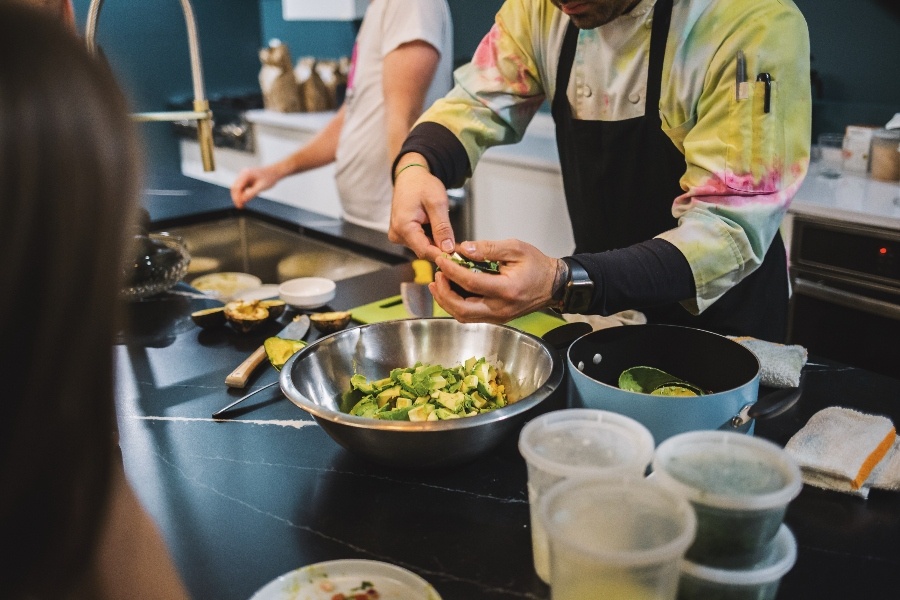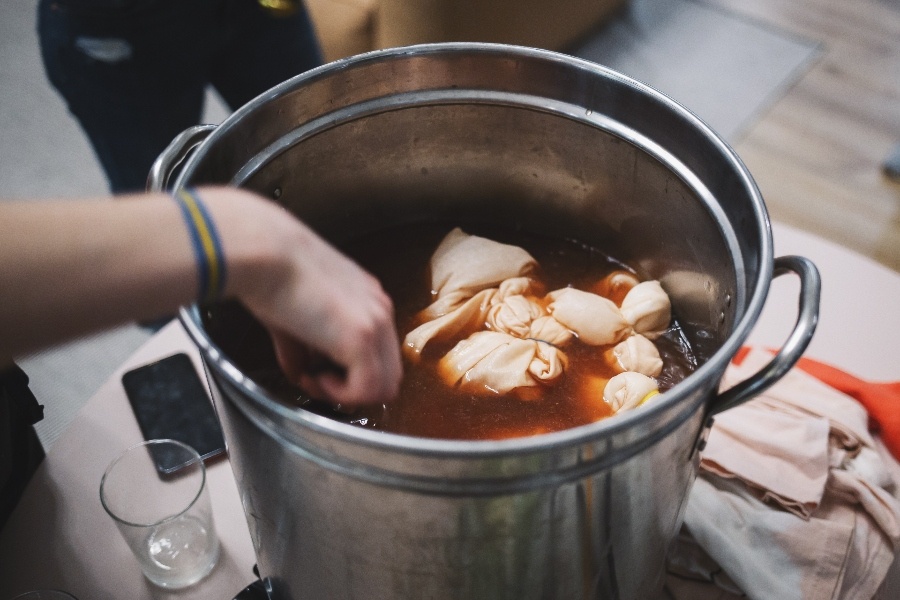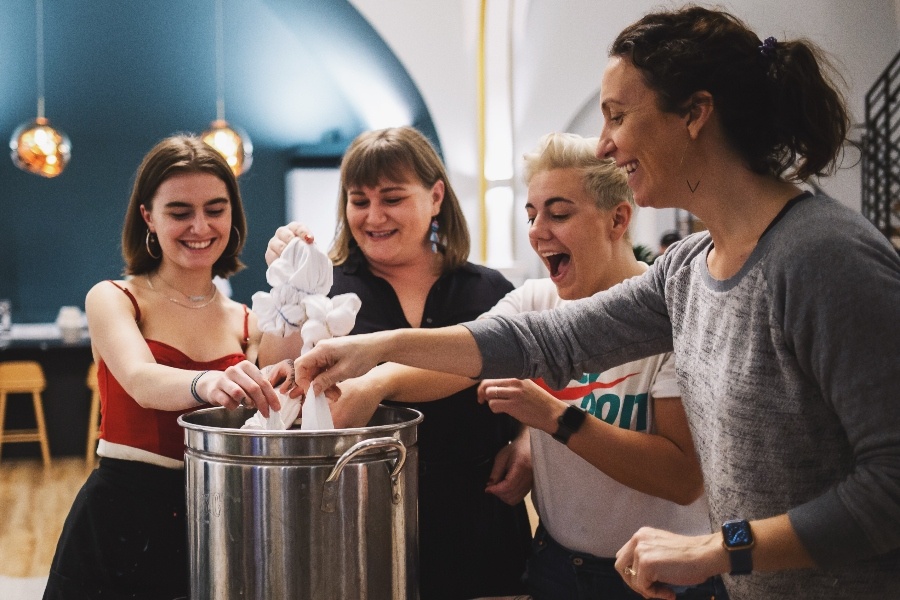I Learned How to Tie-Dye Clothes Using Avocados
Yes, avocados are good for more than just guac.

Photo courtesy of Mission Taqueria and The Deacon
This post has been updated.
At the start of the new year, I made an intention to have a date night with myself at least twice per month. That’s because 2020 is pretty much the busiest year of my life — a new house, my MFA graduation, our wedding, our honeymoon are all happening in the first six months! (*nervous laughter*). With all the packing, moving, writing, and planning to do, I knew my own wellness could potentially get put on the backburner.
So when I saw Mission Taqueria and Philly street artist Amberella were teaming up to host a pre-Valentine’s Day event, I knew I *had* to be there. Guac, guava margs, and a girls’ night with myself? Say no more — you had me at avo.
The workshop, which took place at The Deacon as part of their Experiences series, was DIY tie-dyeing using avocados. Like most millennials, I consume a whole lotta guac, yet had no idea that the fruit — specifically its pit and skin — could be used as a natural coloring agent. But news flash, indigenous folks living across Central and South America have been using avocados to dye fabric long before the Spanish conquest. That’s right, people have been creating no-waste, sustainable fashion for years.

Live guacamole-making demo. / Photograph courtesy of The Deacon.

Tie-dyeing with avocado pits and skins is a no-waste way dye method. / Photograph courtesy of The Deacon.
The night kicked off with some mingling and snacking before all of us attendees gathered around the kitchen island for a live guac-making demo. (Pro tip: use a cookie rack to perfectly cube avocados.) Plus, Amberella talked to us about being a female street artist in Philly, including subverting cat calls and empowering people’s emotional health.
After guac and good conversation, it was time to get our tie-dyeing on! Each of us grabbed a t-shirt, which was screen printed with Amberella’s “UR HOT” (which she designed specifically as a neon installation for Mission a few years ago). At each of the four dye stations was a large vat containing rationed avocado dye and staying warm on a single burner. Isabelle Arnone, who studies fibers and material at Temple University’s Tyler School of Art and Architecture, had prepared the dye ahead of time, so we could get down to business. But don’t worry, she shared her entire process with us (which you can find at the end of this post), so you can easily avo-dye at home!

Putting the shirts into the dye. / Photograph courtesy of The Deacon.
Before we let the shirts soak, Arnone told us that the dye attacks the first fibers it touches, meaning that everybody would need to add their shirts to the dye at the same time to make sure we all got an even amount of color.

Amberella showing her support during the dyeing process. / Photograph courtesy of The Deacon.
After rolling/bunching and rubber-banding, we threw our shirts into the vat and let the 30-minute magic happen. Because avocado pits contain a reddish-brown substance called tannin, the fruit produces a gorgeous dusty rose color, and everyone’s shirts ranged from peachy reds to pinks to mauves.
View this post on Instagram
That night, I walked away not only with a super cute tie-dyed shirt, but having learned how to use, preserve, and even transform what nature provides in a simple, no-waste way. Of course, the empanadas and guava margs were crazy good, but ya know, so is being eco-conscious. Any other way is just totally guacward.
How to tie-dye with avocados at home, according to Isabelle Arnone:
- Soak your desired piece of clothing in hot water with some concentrated pH-neutral detergent called synthrapol.
- With any plant-based dyes, utilizing a binding-agent known as mordant is recommended to ensure the brightest colors and longest wear. I use an alum (potassium aluminum sulfate) mordant, but you can also use iron, copper, and iodine. To create an alum-based mordant, mix alum, calcium carbonate (chalk), soda ash (sodium carbonate, commonly present in baking soda), water, and vinegar. Do this in a well-ventilated area, either outside with a mask or under a functioning vent.
- Ring out the clothing, then transfer to the alum bath to soak for about 48 hours.
- To prepare the dye, you’ll need the skin and pits of seven or eight avocados. Fill one or two large stainless steel pot(s) with enough water for the avocados to swim around and add the avocados. Bring the water to a boil and let cook for about five minutes. The bath will turn a deep reddish-brown, as the tannin will bleed out into the water.
- Turn off the heat and let the pot(s) of avocados sit on the stove overnight in a cool or refrigerated space. Natural dyeing is like making tea; the longer you steep your bath, the stronger the color will be.
- The next day, remove the avocados and strain any remnants, and refrigerate the concentrated dye for up to two days. In the meantime, you can clean and dry your clothing from the mordant bath.
- After letting the dye sit, warm up the pot(s) of dye on a burner, and add your clothing once heated. Let clothing soak for about 30 minutes. The longer the soak, the darker the shade of pink.
- Ring out excess dye, and place clothing in a zip-lock bag. Wait at least 24 hours before hand-washing with a natural, low-pH soap.
Want to hear more from us? Join Be Well Philly at:
FACEBOOK | INSTAGRAM | NEWSLETTER | TWITTER


